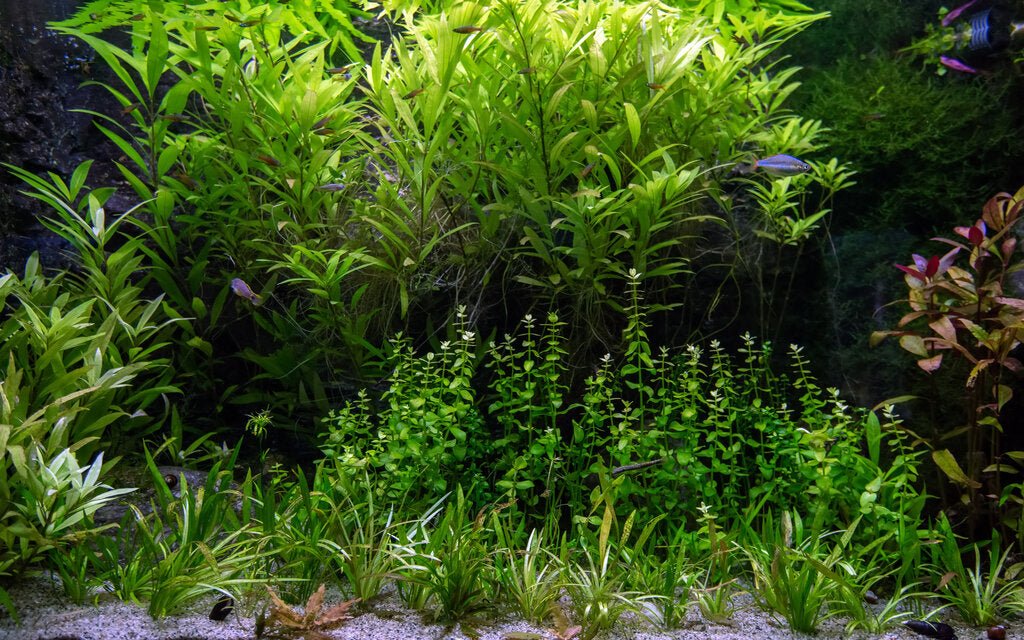Imagine a sanctuary of eternal serenity, where a vibrant tapestry of lush greenery sways beneath crystalline waters, shimmering in the gentle caress of light, and beckoning you to enter a realm of timeless tranquillity. Encompassed within the intimate embrace of your very own planted aquarium, this verdant oasis of aquatic flora represents a dazzling synthesis of nature and art, a sanctuary where passion and creativity converge with boundless potential and imagination. Guiding you on this transformative journey, Perfect Aquatics stands as the paragon of knowledge, expertise, and devotion, providing the assurance of steadfast support through every step of your underwater gardening adventure.
Embrace the allure of planted aquariums with Perfect Aquatics' comprehensive guide, a meticulously curated tome of expert insights, design inspiration, and essential care tips forged from decades of experience in aquatic mastery. Immerse yourself in a world of botanical wonder as you journey through an illuminating exploration of essential topics, ranging from substrate selection and lighting requirements to plant placement and nutrient management. Armed with this veritable treasure trove of vital knowledge, embark on an exquisite journey of self-discovery and creative fulfilment, crafting masterful aquatic displays that captivate the senses and stir the soul.
A Solid Foundation: Choosing the Right Substrate and Tank Setup
Crafting a visually appealing and thriving planted aquarium begins with selecting suitable substrate materials and establishing an optimal tank setup:
- Select the Ideal Substrate: Choose a substrate capable of providing the necessary nutrients to support robust plant growth. Consider options such as nutrient-rich aqua soil, gravel, and sand, bearing in mind the preferences and needs of your chosen aquatic plants.
- Determine the Appropriate Tank Size: Opt for an aquarium size that provides ample space for your desired aquatic plant species to grow and flourish. Factor in the mature size of your plants and the visual aesthetic you wish to achieve.
- Plan Your Tank Layout Strategically: Develop a schematic for the arrangement of your aquatic plants, taking into account their growth patterns, mature sizes, and light requirements. Aim for a well-balanced composition that offers both aesthetics and functionality.
Nourishing Your Aquatic Plants: Lighting, CO2, and Nutrient Management
Providing a healthy environment for your plants involves careful attention to lighting, CO2, and nutrient requirements:
- Provide the Right Amount of Light: Ensure that your planted aquarium receives the correct amount of light to support healthy plant growth. Use a suitable aquarium light to provide a consistent light spectrum for a set duration of hours each day.
- Maintain Optimal CO2 Levels: Consider the implementation of a CO2 injection system to supplement the carbon dioxide available to your plants. CO2 levels in your aquarium should be maintained between 20-30 ppm to encourage robust growth and prevent algae.
- Administer Essential Nutrients: Utilise a comprehensive fertilisation regimen to provide your aquatic plants with essential macro and micronutrients. Regularly monitor and adjust fertilisation to suit the specific needs of your plants.
Planted Aquarium Design Principles: Composition, Balance, and Focal Points
Creating a visually stunning planted aquarium entails the application of fundamental design principles:
- Utilise the Rule of Thirds: Divide your aquarium into nine equal sections using imaginary lines and place key design elements at the intersections of these lines. This creates a balanced and visually appealing layout.
- Integrate a Pleasing Mix of Textures and Colours: Select aquatic plants that display complementary colours, varied textures, and an assortment of shapes and sizes. Use this diversity to create visual interest, contrast, and depth.
- Create Strong Focal Points: Implement one or more focal points within the aquarium design to draw the viewer's attention and guide their gaze throughout the aquascape. These can be vertically oriented plants, accentuating hardscapes, or distinct groupings of plant species.
Caring for Your Planted Aquarium: Maintenance and Monitoring
Effective maintenance and attentive monitoring are essential for maintaining a lush and healthy planted aquarium:
- Perform Regular Water Changes: Conduct weekly water changes of approximately 20-30% to remove excess nutrients and waste products from the aquarium, replenishing it with fresh, treated water.
- Prune and Rearrange Plants as Needed: Regularly monitor your plant growth and trim back overgrown or unhealthy foliage as necessary. In doing so, you allow light to penetrate deeper into the aquarium, encouraging new growth.
- Monitor Key Water Parameters: Test and evaluate essential water parameters such as pH, water hardness, nutrient levels, and temperature to ensure that they remain suitable for your aquatic plants. Adjust as needed to maintain optimal water conditions.
Conclusion
Immerse yourself in the enchanting universe of planted aquariums, a world where the splendour of nature's profusion blooms beneath the mesmerising veil of glassy water. With Perfect Aquatics as your devoted ally, ascend to the pinnacle of aquatic gardening, forging an intimate bond with radiant plant life as it curls, shimmers and sways beneath the caress of a loving embrace. In harmony with the serenade of water and the whisper of emerald dreams, venture upon a journey into the exhilarating depths of botanical creation, transforming the passion that dances in your heart into a tangible, living masterpiece that defies the bounds of the earthly plane.
Entwine your spirit with the transcendent beauty of underwater gardens and discover the serenity, inner peace, and joy that lies at the heart of a flourishing planted aquarium, nurtured to perfection with the unwavering support, expertise, and guidance of Perfect Aquatics. Contact us now to learn more about our superfish tanks and tropical aquariums.

